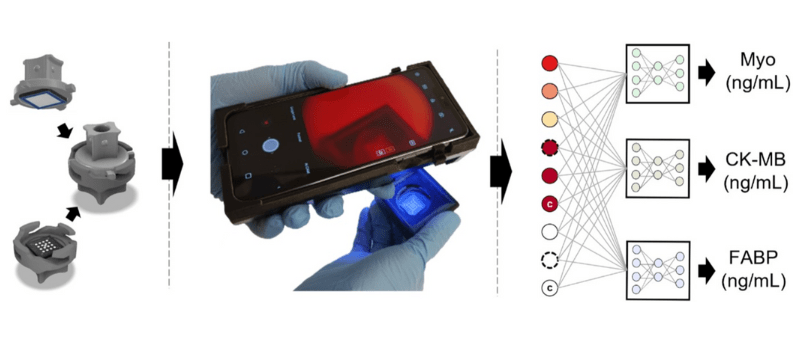Biomarker quantification goes vertical: multiplexed paper-based biosensor for point-of-care testing

Researchers at the University of California, Los Angeles (UCLA; CA, USA) have developed a paper-based biosensor that can detect multiple biomarkers concurrently. The researchers used the biosensor to quantify three acute coronary syndrome (ACS) biomarkers.
In the interest of shortening testing timelines and producing accessible diagnostic tools that can be used in remote and resource-limited regions, point of care (POC) sensors have been developed as alternatives to centralized laboratory testing. Often called lateral flow assays (LFAs), paper-based sensors form the most common type of POC test. The injected sample fluid flows horizontally, reacting with the specific test regions or ‘test lines’, generating a color change, for example. Although simple and cost effective, LFAs possess several constraints such as limited sensitivity and challenges regarding multiplexing.
To address these limitations, a paper-based biosensor has been developed by researchers at UCLA using a fluorescent multiplexed vertical flow assay. The biosensor was used to quantify three cardiac biomarkers from human serum samples simultaneously. The research findings were published in the journal Small.
You may also be interested in:
- Fluorescent biosensor shines light on the activity of the rare-earth metal manganese
- Now that’s what I call biosensors
- Portable quantitative screening test for prostate-specific antigen at point-of-care
The research was led by Aydogan Ozcan, Chancellor’s Professor of Electrical and Computer Engineering and the Associate Director of the California NanoSystems Institute at UCLA and was conducted in collaboration with Professor Dino Di Carlo, UCLA Bioengineering department, Professor Omai Garner, Director of the UCLA Clinical Microbiology Lab, Dr. Hyou-Arm Joung, Senior Research Associate at UCLA and Artem Goncharov, graduate student at UCLA Electrical and Computer Engineering Department.
The new POC sensor offers multiple test regions with up to 100 individual test spots within one disposable cartridge and can achieve a detection limit of more than ~0.5 ng/mL for each biomarker. Using only a droplet of serum and requiring simple operation steps, the biosensor can be used by a minimally trained user in under 15 minutes.
Ozcan commented:
“This design essentially allows us to integrate tens of different POC sensors into a single cassette and perform multiplexed diagnostics tests in parallel with the same low-cost paper-based sensor”.
The researchers used the multiplexed sensor to quantify three ACS biomarkers: myoglobin, creatine kinase-MB (CK-MB) and heart-type fatty acid binding protein (FABP). The results from the paper-based sensor aligned well with measurements obtained by a standard benchtop laboratory test. Additionally, the research team developed a mobile phone-based, hand-held fluorescence reader and deep learning-assisted signal analysis pipeline to automatically perform quantification of the three target biomarkers.
Goncharov further commented:
“Compared to a commonly used linear calibration method, our deep learning-based analysis benefits from the function approximation power of neural networks to learn non-trivial relationships between the multiplexed fluorescence signals from the paper-based sensor and the underlying analyte concentrations in serum. As a result, we have accurate quantitative measurements for all three biomarkers of interest despite the background noise present in clinical serum samples.”
Its ease-of-use, low cost and accuracy when compared to traditional lab-based methods makes this paper-based biosensor an appealing POC tool, especially in remote and resource limited settings.




